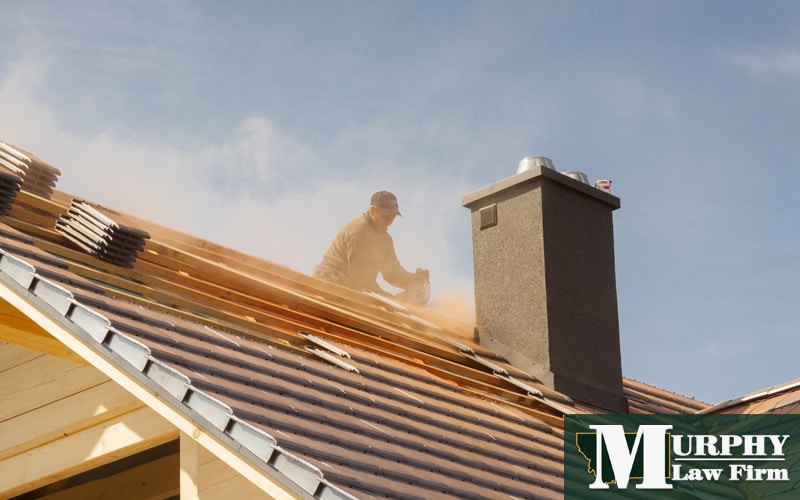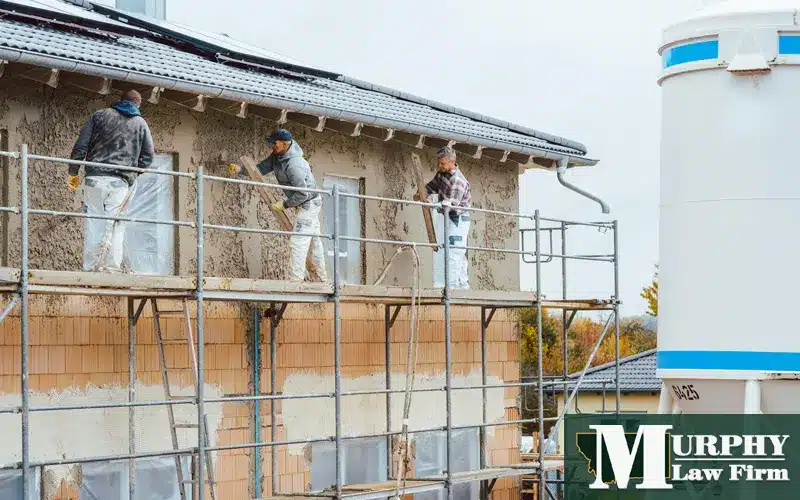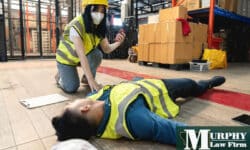
Learn if you qualify for workers’ compensation and how to file a claim to get the benefits you need
Roofers arguably have one of the most difficult jobs in Great Falls, Montana. Because they’re required to work at great heights in various weather conditions, even a common accident like a slip, trip or fall can lead to serious injuries and even death.
Fortunately, most Montana workers are entitled to workers’ compensation benefits after an injury to help with medical bills and lost wages. This article will explain workers’ comp eligibility requirements and how and when to file a claim.
Statistics on roofer injuries
Roofers suffer falls at a higher rate than workers in almost any other industry. In fact, according to statistics from the U.S. Bureau of Labor Statistics (BLS), in 2016, roofers suffered the highest rate of nonfatal injuries from falls from lower levels, with almost 87 out of every 10,000 workers affected.
Painters, construction and maintenance workers collectively had the second-highest rate of injuries in this category, at around 75 for every 10,000 workers.
Meanwhile, in terms of roofing deaths, between 2011 and 2017, about 36 per 100,000 residential roofers suffered fatalities while working on sloped roofs. This is because sloped roofs significantly impact the way workers can maneuver, which increases their chances of falling.
This rate of roofing-related deaths is 10 times higher than the rate of deaths for all other types of construction-related jobs in the country combined.
Most common roofer injuries
Roofing is a physically demanding job that exposes workers to various occupational hazards, resulting in a wide range of work-related injuries.
For example, roofers frequently work in extreme weather conditions such as rain, snow, ice and strong winds. Whether from ladders, roofs or scaffolding, slippery surfaces and poor visibility can contribute to falls from heights that lead to severe injuries such as:
- Fractures
- Head and brain injuries
Other common work injuries among roofers include the following:
- Strains and sprains. Roofing tasks involve repetitive motions, heavy lifting, and awkward postures, which can lead to strains and sprains in muscles, tendons and ligaments. Common areas affected include the back, shoulders, neck and knees.
- Cuts, lacerations and amputations. Roofers often use sharp tools like knives, saws and other cutting instruments, and improper handling or accidents can cause injuries like cuts, lacerations and even amputations that may require medical attention.
- Heat-related illnesses. During the summer months in Montana, roofers often face high temperatures and sun exposure. Prolonged exposure can lead to overexertion illnesses such as heat exhaustion without proper hydration and rest.
- Electrical shocks. Roofers may encounter electrical hazards while working near power lines or during the installation of electrical components. Contact with live wires or faulty equipment can result in electric shocks, burns and other serious injuries.
- Inhalation of hazardous substances. Roofers may be exposed to hazardous substances, such as asbestos fibers, silica dust and other chemicals in roofing materials. Prolonged inhalation or inadequate respiratory protection can lead to breathing problems and occupational diseases like lung cancer and chronic obstructive pulmonary disease (COPD).
- Repetitive motion injuries. Repetitively using certain tools like hammers can put excess strain on the hands, wrists, fingers, shoulders or arms. This can lead to repetitive stress injuries like tendonitis or carpal tunnel syndrome.
Two roofers suffer job-related injuries from the same hazard
Two roofers working on the same construction site in Tennessee on different days experienced the same accident. The incidents occurred 2 days apart, leading to each man falling through a skylight while working on a roof. The first man was knocked unconscious after his fall and suffered bleeding from the nose and mouth and an injured hand. Meanwhile, the second suffered hand and leg injuries.
After the accidents, the state’s Occupational Safety and Health Administration ordered that the work stop to allow time for an investigation into the incidents.
How does Montana define an independent contractor?
To understand if you qualify for workers’ comp benefits in Montana, you must first understand the distinction between being an employee vs independent contractor.
In Montana, an independent contractor is defined as a worker who has their own independently established business, occupation or trade. They are free of direction or control from the company that hires them. This means that although they may be hired to do a specific job, the company that hires them generally doesn’t control the means by which the job is performed.
By contrast, an employee is under the control of the company that hires them and is required to perform specified tasks according to the directions given to them by their employer.
Do independent contractors qualify for workers’ compensation in Montana?
An independent contractor is exempt from workers’ comp, meaning they don’t qualify for coverage under an employer’s workers’ compensation insurance. Instead, under Montana law, independent contractors are required to purchase their own workers’ compensation policy or obtain an Independent Contractor Exemption Certificate (ICEC). Failure to do so can result in fines of up to $5,000 per violation.
What legal options do roofers have if they’re injured as an independent contractor?
If a roofer is an independent contractor and suffers an injury after an accident, they may have a few legal options depending on the circumstances of their case:
- Personal injury lawsuit. If a third party, such as a property owner, general contractor, or another subcontractor, was responsible for the injury due to negligence or unsafe conditions, the injured roofer may have grounds to pursue a personal injury lawsuit. This may allow them to seek compensation for medical expenses, lost wages, pain and suffering and other damages.
- Product liability claim. If a ladder, scaffolding or other equipment used by the roofer is found to be defective or unreasonably dangerous, resulting in injury, they may have grounds for a product liability lawsuit. This type of claim holds manufacturers, distributors and sellers responsible for injuries caused by defective products, and it may allow the injured roofer to seek compensation for damages.
- Employer misclassification. In some cases, roofers classified as independent contractors may actually be misclassified under Montana law. If an independent contractor can demonstrate that they were misclassified and should be considered an employee, they may have access to additional legal protections and benefits typically afforded to employees.
If you were injured working as an independent contractor or you believe your employer misclassified you, contact an experienced work injury attorney to discuss your legal options.
Montana workers’ compensation claims process
Read our step-by-step instructions and timeline for filing a work injury claim in Montana.
Which workers are eligible for workers’ compensation in Montana?
In Montana, workers are eligible for workers’ compensation if they are regular full- or part-time employees of a business and suffer job-related injuries or illnesses. Sole proprietors and LLC members are generally excluded from workers’ comp but can elect to obtain coverage to protect themselves.
Eligible workers are entitled to workers’ comp benefits if their injuries or illnesses are directly related to their jobs. This means they don’t have to prove anyone was negligent to receive benefits.
As long as their injury or illness resulted from their job duties or work environment, they can file for workers’ compensation benefits. However, injuries that are self-inflicted or sustained while a worker is under the influence of alcohol or drugs are not covered.
What workers’ comp benefits are available to injured roofers?
There are different types of workers’ comp benefits available to Montana employees injured on the job. They include the following:
- Medical benefits. Workers can recover compensation to cover the costs of their medical expenses, including hospital stays, prescriptions, surgeries, doctor visits, rehabilitation and medical supplies.
- Lost wages. Injured workers who cannot work during their recovery period can receive lost wage benefits on the fifth day of wage loss, which are typically two-thirds of their average weekly wage.
- Death benefits. If a worker is killed on the job, their surviving family members can receive death benefits for up to 500 weeks. They can also recover up to $4,000 to cover funeral and burial costs.
Steps to file a workers’ compensation claim in Montana
Injured Montana workers who wish to file a workers’ compensation claim should take the following steps:
- Notify your employer. Your employer should be notified of your injury within 30 days.
- Employer files report. The employer must file a First Report of Injury (FROI) form within 6 days of being notified of your injury.
- Claim filed with workers’ comp. The employer then files a claim on the worker’s behalf with the workers’ compensation insurance carrier within 1 year.
- Ruling. The insurance company will then either accept or deny the claim within 30 days of the filing.
- Appeal (if denied). If your claim is denied, you can file an appeal within 2 years, but it’s highly recommended that you contact a workers’ compensation attorney to assist you with the process.
Contact an experienced Montana work injury attorney
If you’ve been injured in a serious roofing accident in Montana, consider contacting an experienced workers’ compensation attorney to help with your claim. An attorney knows how to estimate the value of your claim based on your injuries and future medical care and can negotiate with your employer and their insurance company to ensure you get maximum compensation.
At Murphy Law Firm, our dedicated workers’ compensation attorneys have more than 75 years of combined experience helping injured workers in Montana get the compensation they deserve.
Contact us today for a free consultation of your case.
Montana Workers’ Compensation for Scaffolding & Ladder Accidents
Understand your right to compensation and how to maximize your benefits after a fall from a ladder or scaffold at work.





